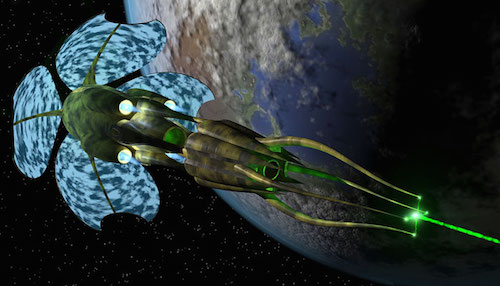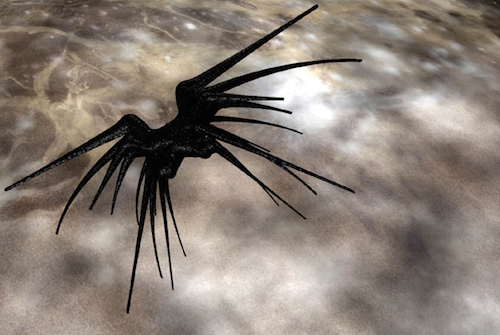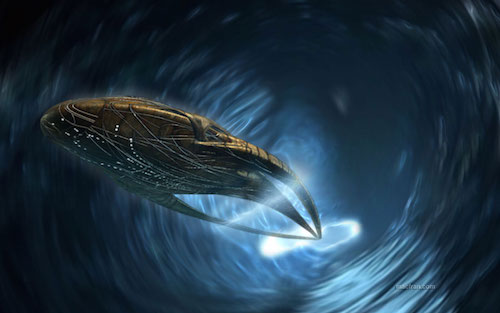
November might be the month of grey, dreary weather and the first fogs, the transition month that brings us into winter, and as such it’s never been my favorite month of the year – that is, until book blogging made me aware of this month-long event celebrating science fiction in all its forms. And that made November a lot prettier, indeed…
SciFi Month 2018 is hosted by Imyril and Lisa and you can follow the links to know more about the event and how to participate.
It’s not always been possible for me to be very active in this SF festival, but even when I could not be a part of it, I’ve always enjoyed reading other bloggers’ contribution. Since I have not prepared for the event, I doubt I will be able to post much, but this year the Photo Challenge comes to my aid, allowing me to share some of my love of science fiction through images.
THE BEST SHIP IN THE UNIVERSE
Ships are of course at the center of the majority of SF stories – otherwise how could you travel from one side of the universe to the other? Or be protected by the hostile, lifeless, deadly cold of space?
For this gallery I have tried to steer away from the most obvious choices like the many incarnations of Star Trek‘s Enterprise, or the almost endless range of ships one can find in the Star Wars universe, and rather went for the vessels from the shows that are closest to my heart, those that still spark a strong emotion every time I see them
I will start with a blast from the past, and travel back to the mid-70s with SPACE: 1999, the show that did not only bring to our small screens the fascinating journey of Earth’s Moon turned rogue after a devastating explosion, but also an amazing visual concept for the interiors of the Moon Base, and its technology, that for the times looked quite advanced. Well, if you forget the main computer spewing its answers on a thin strip of paper, that is… The means of transportation from Moonbase Alpha to the various planets our heroes encountered in their journeys was called Eagle, it it was a very interesting design, both functional and believable: one of the elements I always liked was the central module that could be detached from the main frame and exchanged for a different payload. Thinking about it now, that shape was not so different from that of current NASA shuttles, was it?

FIREFLY was a delightful little show obliterated before its time by the usual short-sightedness of network executives, and it focused on humanity’s diaspora through the stars, in an era when old Earth seemed to be little more than a myth and colonization was still ongoing on several worlds, whose wild frontier look made the show appear like a mix between science fiction and classic western, complete with six-shooters wielded with extreme ease. Serenity is the ship housing the main characters, a group of rebels fighting the centralized power and trying to eke out a living by smuggling and sometimes stealing: the best parts of the story, for me, where those where the somewhat dysfunctional family aboard the ship gathered around the mess-hall table, laughing, joking and quarreling, secure in their knowledge that their beloved ship would protect them as long as they kept taking care of it.

And of course it was a given that I would end up talking about what I consider THE science fiction show by definition: BABYLON 5, a story that will never grow old, or anachronistic, because it’s not based on ground-breaking concepts or special effects, but rather on the study of the human (and alien!) soul, on the way in which ordinary people react to extraordinary events and try to give their best. The simple fact that it’s filled with an incredible amount of worthy quotes that can be applied to any kind of situation is the proof of its depth and durability. And yes, I’m just a tiny bit biased toward it… Human ships, in the B5 universe, are somewhat clunky and not exactly aesthetically pleasing, still having to rely on rotating sections to obtain artificial gravity, but the alien ships… well, they are something completely different.
Take the Minbari cruisers, for example: they are beautiful, reflecting their creators’ love for form and function mated in a seamless whole, but at the same time they do look deadly, as the humans learned in the conflict that pitched Minbari and humans against each other 10 years before the B5 timeline starts.

And then there are the Vorlons, the mysterious aliens with an equally mysterious agenda, whose ships can open some sort of solar sail that looks like a flower, while the main vessel resembles more the shape of an octopus. The two elements might sound improbable together, and yet they create a thing of beauty – and let’s not forget that Vorlon ships and partially sentient, and that when their owners die they prefer to follow them in death rather that go on without a part of what makes them what they are.

But of course in the B5 universe there are also evil creatures, like the Shadows, whose war of conquest is carried out through their impressive, cruel-looking ships that have all the appearance of a spider ready to pounce. Their approach is always announced by a horrifying screech that freezes the blood in your veins, and if that’s not enough to scare you, remember that their guidance systems requires an… organic component, a telepath melded to the machine as an integral part of the ship. The stuff of nightmares, indeed…

Since I could not leave you with such a blood-curling image at the end of this post, I’m closing this list of ships with a very special one, a living ship – a creature born and bred in space that can house people in its quite comfortable interior, shelter them and adapt to their needs. The Leviathan Moya, from FARSCAPE, is such a ship, a gentle creature who looks a little like a whale, and whose sight never fails to put a fond smile on my face.















You must be logged in to post a comment.